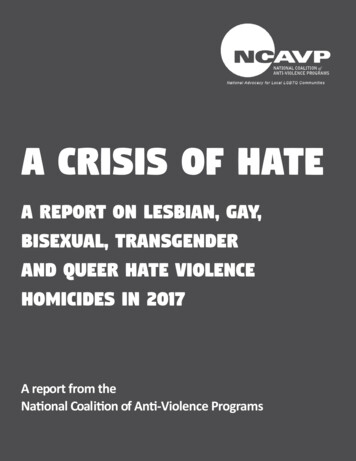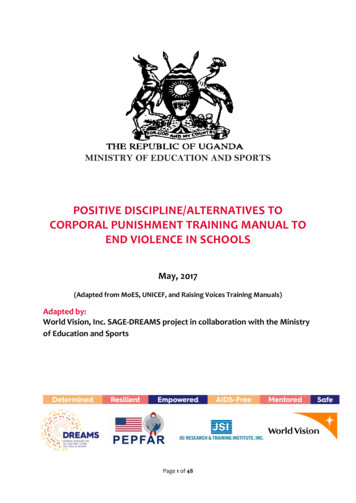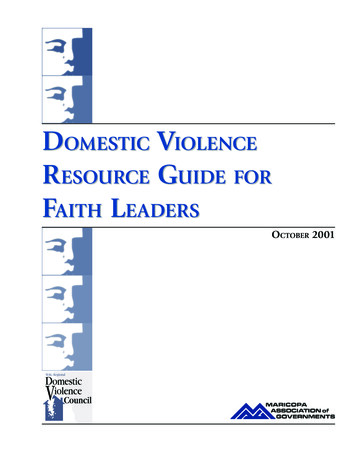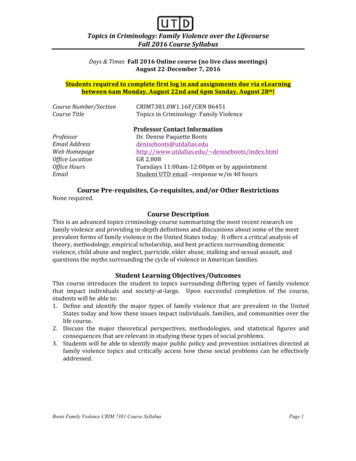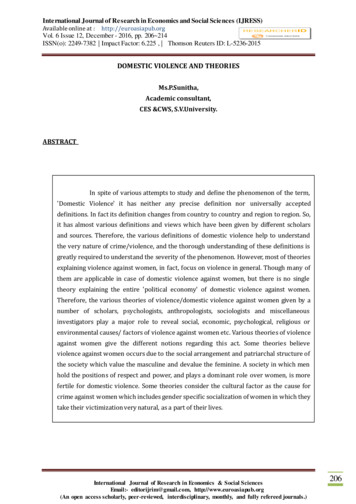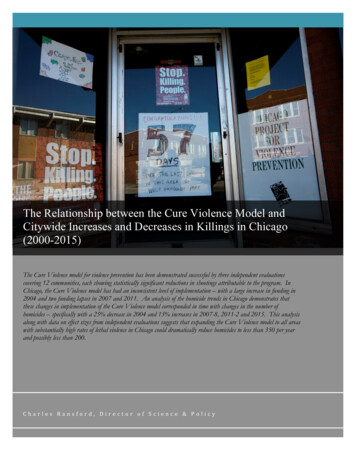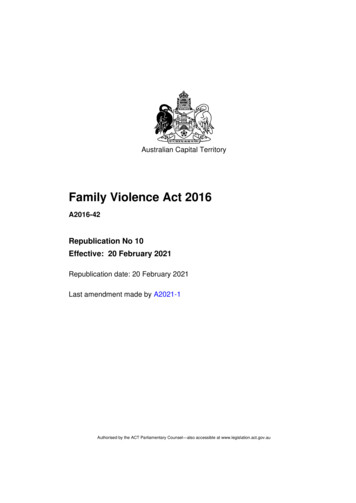
Transcription
Australian Capital TerritoryFamily Violence Act 2016A2016-42Republication No 10Effective: 20 February 2021Republication date: 20 February 2021Last amendment made by A2021-1Authorised by the ACT Parliamentary Counsel—also accessible at www.legislation.act.gov.au
About this republicationThe republished lawThis is a republication of the Family Violence Act 2016 (including any amendment made underthe Legislation Act 2001, part 11.3 (Editorial changes)) as in force on 20 February 2021. It alsoincludes any commencement, amendment, repeal or expiry affecting this republished law to20 February 2021.The legislation history and amendment history of the republished law are set out in endnotes 3and 4.Kinds of republicationsThe Parliamentary Counsel’s Office prepares 2 kinds of republications of ACT laws (see the ACTlegislation register at www.legislation.act.gov.au): authorised republications to which the Legislation Act 2001 applies unauthorised republications.The status of this republication appears on the bottom of each page.Editorial changesThe Legislation Act 2001, part 11.3 authorises the Parliamentary Counsel to make editorialamendments and other changes of a formal nature when preparing a law for republication.Editorial changes do not change the effect of the law, but have effect as if they had been made byan Act commencing on the republication date (see Legislation Act 2001, s 115 and s 117). Thechanges are made if the Parliamentary Counsel considers they are desirable to bring the law intoline, or more closely into line, with current legislative drafting practice.This republication does not include amendments made under part 11.3 (see endnote 1).Uncommenced provisions and amendmentsIf a provision of the republished law has not commenced, the symbol U appears immediatelybefore the provision heading. Any uncommenced amendments that affect this republished laware accessible on the ACT legislation register (www.legislation.act.gov.au). For moreinformation, see the home page for this law on the register.ModificationsIf a provision of the republished law is affected by a current modification, thesymbol M appears immediately before the provision heading. The text of the modifyingprovision appears in the endnotes. For the legal status of modifications, see the Legislation Act2001, section 95.PenaltiesAt the republication date, the value of a penalty unit for an offence against this law is 160 for anindividual and 810 for a corporation (see Legislation Act 2001, s 133).Authorised by the ACT Parliamentary Counsel—also accessible at www.legislation.act.gov.au
Australian Capital TerritoryFamily Violence Act 2016ContentsPagePreamblePart 11345Part 22PreliminaryName of ActDictionaryNotesOffences against Act—application of Criminal Code etc3334Objects and important conceptsDivision 2.1Objects6Objects of Act7How objects are to be achieved55Division 2.2Important concepts8Meaning of family violence9Meaning of family member68R1020/02/21Family Violence Act 2016Effective: 20/02/21Authorised by the ACT Parliamentary Counsel—also accessible at www.legislation.act.gov.aucontents 1
ContentsPage1011Meaning of intimate partnerMeaning of relative910Division 2.3Other important matters12Principle about procedures13Balance of probabilities13ARules of evidencePart 3121213Family violence ordersDivision 3.11415Matters to be considered when making family violenceordersMatters to be considered—family violence ordersFamily Law Act orderDivision 3.2Applications for protection orders16Who may apply for protection order?16AChild may apply for protection order in same application as parent16BApplications by police officers17Application forms that require affected person’s address18What if application is made for the wrong order?19What if application for the wrong order is decided?Division 3.3171818181919Interim ordersSubdivision 3.3.1Making interim orders20Interim orders—only on application for final order21Interim orders—grounds for making22Interim orders—general interim orders and special interim orders202121Subdivision 3.3.2General interim orders23General interim orders—only 1 may be made24General interim orders—length25General interim orders—ending26General interim orders—taken to be special interim orders if relatedcharges laid27General interim orders—further orders28General interim orders—extension for non-service of application29General interim orders—extension for non-service of final ordercontents 21416Family Violence Act 2016Effective: 20/02/21Authorised by the ACT Parliamentary Counsel—also accessible at 1
ContentsPageSubdivision 3.3.3Special interim orders30Special interim orders—ending31Special interim orders—application not to be decided until relatedcharges finalised32Special interim orders—final application decided252626Division 3.4Consent orders33Consent orders33AConsent to interim order becoming final order2829Division 3.5Final orders34Final orders—grounds for making35Final orders—length3031Division 3.6Conditions of family violence orders36Safety of affected person and children paramount37Least restrictive principle38Conditions—general39Exclusion conditions40Personal property orders41Conditions—consent orders42Conditions may apply for shorter time than order31323235363636Division 3.7Effect of family violence orders43Offence—contravention of family violence order44Firearms licences3738Part 4Procedural mattersDivision 4.145464748What Magistrates Court must do after receivingapplication for protection orderMeaning of timing noticeInterim order not soughtInterim order soughtService of application etc on othersDivision 4.2Preliminary conferences49Preliminary conferences—generally50Adjournment of preliminary conference for non-service51If no consent order at preliminary conferenceR1020/02/21Family Violence Act 2016Effective: 20/02/21Authorised by the ACT Parliamentary Counsel—also accessible at www.legislation.act.gov.au39394041414242contents 3
ContentsPageDivision 4.2ANon-attendance by party52Meaning of returned before the court—div 4.2A53Applicant not present at return of application54Respondent not present at return of application54ANeither party present at return of application43434344Division 4.3Hearings58Hearings usually in public59Public hearing not required60Closed hearings in special circumstances60ANotice of grounds of defence60BApplicant may rely on additional information in hearing60CIf child and child’s parent are affected people60DChildren as witnesses61Discontinuance62Admissibility of preliminary conference evidence62AGiving evidence by affidavit for interim order63Examination of affected person by self-represented respondent64Undertakings by respondent65Court may inform itself44454546474748484949495151Division 4.4Making of protection orders66Explaining orders if respondent present67Explaining orders if protected person present68Reasons for order69Orders generally not to include protected person’s address51525354Division 4.4AService of documents70APersonal service of application on respondent70BDismissal of application for non-service70CService of protection orders70DSelf-represented parties70EService of documents by police70FGiving documents to child or child’s parent or guardian70GAffidavit of service of documents by police54545556565657Division 4.5Other procedural matters71Police officer party to proceeding—substitution of applicant etc57contents 4Family Violence Act 2016Effective: 20/02/21Authorised by the ACT Parliamentary Counsel—also accessible at www.legislation.act.gov.auR1020/02/21
ContentsPage71A73Request for further particularsCosts5858Division 4.6Party with impaired decision-making ability74Meaning of impaired decision-making ability75Child respondents76Representation—party with impaired decision-making ability77Consent orders—party with impaired decision-making ability59606061Division 4.7Appointment etc of litigation guardian78Litigation guardian—appointment79Litigation guardian—powers80Litigation guardian—responsibilities81Litigation guardian—removal62626363Part 58282A83848586Part 6878889909191A9293959697R1020/02/21Amendment of protection ordersAmendment of protection orders—who may applyPreliminary conferencesAmendment of protection ordersFinal orders—temporary amendmentGeneral interim orders made by consent—extensionFinal orders—extension646465666666Review of ordersSpecial interim orders—application for reviewSpecial interim orders—reviewFinal orders—application for reviewFinal orders—reviewConsent orders—reviewPreliminary conferencesAppealable decisionsAppeals to Supreme CourtEvidence on appealPowers of Supreme Court on appealEffect of filing appealFamily Violence Act 2016Effective: 20/02/21Authorised by the ACT Parliamentary Counsel—also accessible at ntents 5
ContentsPagePart 79899100101102103104105106107108109110After-hours ordersMeaning of business hours—pt 7Police officer may apply for after-hours orderAfter-hours orders—grounds for makingAfter-hours orders—applicationAfter-hours orders—makingAfter-hours orders—refusalAfter-hours orders—recordsAfter-hours orders—detention of person against whom order soughtAfter-hours orders—lengthAfter-hours orders—amendment or revocationService of after-hours ordersPolice required to explain after-hours ordersPolice to give reasons for not applying for after-hours orderPart 8111112113114Court-initiated actionsApplication—pt 8Court-initiated interim ordersInterim court-initiated protection order taken to be special interim orderAmendment of existing protection order if later family violence chargePart 979798081National recognition of FVOsDivision 9.1Preliminary115Definitions—pt 9116Meaning of family violence concern—pt 9117Meaning of properly notified—pt 9118Special provisions for registered foreign ordersDivision 9.282848586National recognition of FVOsSubdivision 9.2.1General principles119Recognition of FVOs120Amendment of FVOs121Revocation of recognised FVOs122Recognised FVO prevails over earlier comparable FVOs123Making new orderscontents 673737374757676767777787878Family Violence Act 2016Effective: 20/02/21Authorised by the ACT Parliamentary Counsel—also accessible at www.legislation.act.gov.au8687878889R1020/02/21
ContentsPageSubdivision 9.2.2Enforcement of recognised FVOs124Recognised FVOs and amendments are enforceable againstrespondent125Contravention of enforceable recognised FVOs8990Subdivision 9.2.3Enforcement of non-local FVOs126Non-local FVOs to be treated as local FVOs127Licences, permits and other authorisations128Recognition of disqualification to hold firearms licence129Recognition of disqualification to hold prohibited weapons permit130Costs—non-local FVO9191929394Division 9.3131132133134Amendment and revocation of recognised non-localFVOsMeaning of court—div 9.3Power of court to amend or revoke recognised non-local FVOsApplication for amendment or revocation of recognised non-local FVODecision about hearing of application94949595Division 9.3ARegistration of foreign orders134AApplications for registration of foreign orders134BRegistration of foreign orders9697Division 9.4Exchange of information135Issuing authorities may obtain FVO information136Issuing authorities must provide FVO information137Law enforcement agencies may obtain FVO information138Information to be provided to law enforcement agencies97979898Division 9.5Other matters139Certificate evidence—notification98Division 9.6Application of pt 9—existing protection ordersSubdivision 9.6.1Preliminary140Meaning of commencement day—div 9.6141Enforcement of FVOs under other provisions9999Subdivision 9.6.2FVOs to which scheme applies142FVOs made in the ACT143FVOs made in other jurisdictions100100R1020/02/21Family Violence Act 2016Effective: 20/02/21Authorised by the ACT Parliamentary Counsel—also accessible at www.legislation.act.gov.aucontents 7
ContentsPageSubdivision 9.6.3Extension of scheme to older FVOs144FVOs declared to be recognised FVOs145FVOs declared to be recognised in other jurisdictions beforecommencement daySubdivision 9.6.4Power to declare FVO to be recognised146Power to declare FVO to be recognised147Application for order148Functions of registrar may be exercised by courtPart 10101101102103103MiscellaneousDivision 10.1Public access and publication149Publication of reports about proceedings—offence150Publication of reports about proceedings—exceptions to offence104105Division 10.2Other matters151Deciding application if criminal proceedings152Criminal and civil liability not affected by family violence orders153Crimes Act, s 397 (1)154Working out time if less than 5 days155Regulation-making power105106106106106Part 22205206207208209210COVID-19 emergency responseMeaning of COVID-19 emergency—pt 22Extending general interim ordersRequirement for party to be presentRequirement for party to give consentAcknowledgment of undertaking by respondentExpiry—pt 22Schedule 11.11.2contents 8Permitted publication about proceedingsDefinitions—sch 1Permitted publication about proceedingsFamily Violence Act 2016Effective: 20/02/21Authorised by the ACT Parliamentary Counsel—also accessible at 109R1020/02/21
2129130R1020/02/21About the endnotesAbbreviation keyLegislation historyAmendment historyEarlier republicationsExpired transitional or validating provisionsFamily Violence Act 2016Effective: 20/02/21Authorised by the ACT Parliamentary Counsel—also accessible at www.legislation.act.gov.aucontents 9
Australian Capital TerritoryFamily Violence Act 2016An Act to protect people from family violence, and for other purposesR1020/02/21Family Violence Act 2016Effective: 20/02/21Authorised by the ACT Parliamentary Counsel—also accessible at www.legislation.act.gov.aupage 1
PreamblePreamble1In enacting this Act, the Legislative Assembly recognises the followingprinciples:(a) family violence is unacceptable in any form;(b) freedom from family violence is a human right;(c) the justice system should respect and protect all human rights inaccordance with the Human Rights Act 2004 and internationallaw;(d) family violence is best addressed through a coordinated legaland social response of assistance to victims and the preventionof violence by such things as promoting the accountability ofperpetrators of family violence and the appropriate interventionby the police and the courts.2The Legislative Assembly also recognises the following features of familyviolence:(a) anyone can be a victim of family violence: it occurs in all areasof society, regardless of location, socioeconomic and healthstatus, age, culture, gender, sexual identity, ability, ethnicity orreligion;(b) family violence is predominantly committed by men againstwomen and children;(c) family violence extends beyond physical violence and mayinvolve the exploitation of power imbalances and patterns ofabuse over many years;(d) children exposed to family violence are particularly vulnerableand the exposure may have a serious impact on their current andfuture physical, psychological and emotional wellbeing.The Legislative Assembly for the Australian Capital Territory therefore enacts asfollows:page 2Family Violence Act 2016Effective: 20/02/21Authorised by the ACT Parliamentary Counsel—also accessible at www.legislation.act.gov.auR1020/02/21
PreliminaryPart 1Section 1Part 11PreliminaryName of ActThis Act is the Family Violence Act 2016.3DictionaryThe dictionary at the end of this Act is part of this Act.4Note 1The dictionary at the end of this Act defines certain terms used in thisAct, and includes references (signpost definitions) to other terms definedelsewhere.For example, the signpost definition ‘firearm—see the FirearmsAct 1996, section 6.’ means that the term ‘firearm’ is defined in thatsection and the definition applies to this Act.Note 2A definition in the dictionary (including a signpost definition) applies tothe entire Act unless the definition, or another provision of the Act,provides otherwise or the contrary intention otherwise appears (seeLegislation Act, s 155 and s 156 (1)).NotesA note included in this Act is explanatory and is not part of this Act.NoteR1020/02/21See the Legislation Act, s 127 (1), (4) and (5) for the legal status of notes.Family Violence Act 2016Effective: 20/02/21Authorised by the ACT Parliamentary Counsel—also accessible at www.legislation.act.gov.aupage 3
Part 1PreliminarySection 55Offences against Act—application of Criminal Code etcOther legislation applies in relation to offences against this Act.page 4Note 1Criminal CodeThe Criminal Code, ch 2 applies to all offences against this Act (seeCode, pt 2.1).The chapter sets out the general principles of criminal responsibility(including burdens of proof and general defences), and defines terms usedfor offences to which the Code applies (eg conduct, intention,recklessness and strict liability).Note 2Penalty unitsThe Legislation Act, s 133 deals with the meaning of offence penaltiesthat are expressed in penalty units.Family Violence Act 2016Effective: 20/02/21Authorised by the ACT Parliamentary Counsel—also accessible at www.legislation.act.gov.auR1020/02/21
Objects and important conceptsObjectsPart 2Division 2.1Section 6Part 2Objects and important conceptsDivision 2.1Objects6Objects of ActThe objects of this Act include—(a) to prevent and reduce family violence; and(b) to ensure the safety and protection of people, including children,who fear, experience or witness family violence; and(c) to encourage perpetrators of family violence to be accountablefor their conduct.7How objects are to be achievedThis Act aims to achieve its objects by—(a) giving the courts power to make family violence orders toprotect people from family violence; and(b) creating offences to enforce family violence orders; and(c) ensuring that access to the courts is as simple, quick andinexpensive as is consistent with justice; and(d) by recognising family violence orders made elsewhere inAustralia and New Zealand.R1020/02/21Family Violence Act 2016Effective: 20/02/21Authorised by the ACT Parliamentary Counsel—also accessible at www.legislation.act.gov.aupage 5
Part 2Division 2.2Objects and important conceptsImportant conceptsSection 8Division 2.28Important conceptsMeaning of family violence(1) In this Act:family violence means—(a) any of the following behaviour by a person in relation to a familymember of the person:(i) physical violence or abuse;(ii) sexual violence or abuse;(iii) emotional or psychological abuse;(iv) economic abuse;(v) threatening behaviour;(vi) coercion or any other behaviour that—(A) controls or dominates the family member; and(B) causes the family member to feel fear for the safety orwellbeing of the family member or another person; or(b) behaviour that causes a child to hear, witness or otherwise beexposed to behaviour mentioned in paragraph (a), or the effectsof the behaviour.Examples—par (b)123page 6overhearing threats being made in another room of the houseseeing an assault or seeing injuries on a family member who has beenassaultedseeing people comfort a family member who has been abusedFamily Violence Act 2016Effective: 20/02/21Authorised by the ACT Parliamentary Counsel—also accessible at www.legislation.act.gov.auR1020/02/21
Objects and important conceptsImportant conceptsPart 2Division 2.2Section 8(2) Without limiting subsection (1), family violence by a person inrelation to a family member of the person includes the following:(a) sexually coercive behaviour;(b) damaging property;(c) harming an animal;(d) stalking;(e) deprivation of liberty.(3) In this section:economic abuse, of a family member, means behaviour by a personthat is coercive, deceptive or that unreasonably controls the familymember without the family member’s consent including by theperson’s exploitation of power imbalances between the person andthe family member—(a) in a way that takes away the financial independence or controlthe family member would have but for the behaviour; or(b) if the family member is wholly or predominantly dependent onthe person for financial support to meet the living expenses ofthe family member or the family member’s child—bywithholding the financial support.Examples12345R1020/02/21stopping the family member from having access to money to meet normalliving expensesrequiring the family member to transfer or hand over control of assets orincomestopping the family member from trying to get employmentforcing the family member to sign a legal document such as a power ofattorney, loan, guaranteeforcing the family member to claim social security paymentsFamily Violence Act 2016Effective: 20/02/21Authorised by the ACT Parliamentary Counsel—also accessible at www.legislation.act.gov.aupage 7
Part 2Division 2.2Objects and important conceptsImportant conceptsSection 9emotional or psychological abuse, of a family member, meansbehaviour by a person that torments, intimidates, harasses or isoffensive to the family member including by the person’s exploitationof power imbalances between the person and the family member.Examples1234569stopping the family member from visiting or having contact with family orfriendsstopping the family member from engaging in cultural or spiritual practicesrepeated derogatory or racist commentsthreatening to disclose personal information about the family memberthreatening to withhold medication, personal health care items or other thingsnecessary to the family member’s health or quality of lifethreatening to self-harm as a way of intimidating the family memberMeaning of family memberIn this Act:family member, of a person, means—(a) a domestic partner or former domestic partner of the person; or(b) an intimate partner or former intimate partner of the person; or(c) a relative of the person; or(d) a child of a domestic partner or former domestic partner of theperson; or(e) a parent of a child of the person.page 8Note 1A domestic partner need not be an adult (see Legislation Act, s 169).Note 2Intimate partner—see s 10.Relative—see s 11.Family Violence Act 2016Effective: 20/02/21Authorised by the ACT Parliamentary Counsel—also accessible at www.legislation.act.gov.auR1020/02/21
Objects and important conceptsImportant conceptsPart 2Division 2.2Section 1010Meaning of intimate partner(1) In section 9:intimate partner, of a person—(a) means someone with whom the person has an intimaterelationship, whether they are members of the same householdor not; but(b) does not include—(i) a domestic partner; or(ii) another person with whom the person has a relationshiponly because a service is provided between them—(A) for fee or reward; or(B) on behalf of another person (including a governmentor corporation); or(C) on behalf of an organisation the principal objects orpurposes of which are charitable or benevolent.(2) For subsection (1), factors that indicate whether there is an intimaterelationship between 2 people include, but are not limited to, thefollowing:(a) the extent to which each is personally dependent on the other;(b) the extent to which each is financially dependent on the other(including any arrangements for financial support);(c) the length of the relationship;(d) the frequency of contact between each other;R1020/02/21Family Violence Act 2016Effective: 20/02/21Authorised by the ACT Parliamentary Counsel—also accessible at www.legislation.act.gov.aupage 9
Part 2Division 2.2Objects and important conceptsImportant conceptsSection 11(e) if there is, or has been, a sexual relationship;(f) the extent to which each is involved in, or knows about, theother’s personal life;(g) the degree of mutual commitment to a shared life;(h) if the 2 people share care or support for children or otherdependents.11Meaning of relative(1) In section 9:relative, of a person—(a) means the person’s—(i) father, mother, grandfather, grandmother, stepfather,stepmother, father-in-law or mother-in-law; or(ii) son, daughter, grandson, granddaughter,stepdaughter, son-in-law or daughter-in-law; orstepson,(iii) brother, sister, half-brother, half-sister, stepbrother,stepsister, brother-in-law or sister-in-law; or(iv) uncle, aunt, uncle-in-law or aunt-in-law; or(v) nephew, niece or cousin; and(b) if the person has or had a domestic partner (other than a spouseor civil union partner)—includes someone who would have beena relative mentioned in paragraph (a) if the person had beenmarried to or in a civil union with the domestic partner; andNotepage 10For ACT law, a person acquires relatives through civil union in thesame way as they acquire them through marriage (see Civil UnionsAct 2012, s 6 (2)).Family Violence Act 2016Effective: 20/02/21Authorised by the ACT Parliamentary Counsel—also accessible at www.legislation.act.gov.auR1020/02/21
Objects and important conceptsImportant conceptsPart 2Division 2.2Section 11(c) includes—(i) someone who has been a relative mentioned inparagraph (a) or (b) of the person; and(ii) if the person is an Aboriginal or Torres Strait Islanderperson, the following people:(A) someone the person has responsibility for, or aninterest in, in accordance with the traditions andcustoms of the person’s Aboriginal or Torres StraitIslander community;(B) someone who has responsibility for, or an interest in,the person in accordance with the traditions andcustoms of the person’s Aboriginal or Torres StraitIslander community; and(iii) someone regarded and treated by the person as a relative;and(iv) someone with whom the person has a family-likerelationship; and(v) anyone else who could reasonably be considered to be, orhave been, a relative of the person.(2) For subsection (1) (c) (iv), factors that indicate whether there is afamily-like relationship between 2 people include, but are not limitedto, the following:(a) the extent to which each is personally dependent on the other;(b) the extent to which each is financially dependent on the other(including any arrangements for financial support);(c) the length of the relationship;(d) the frequency of contact between each other;R1020/02/21Family Violence Act 2016Effective: 20/02/21Authorised by the ACT Parliamentary Counsel—also accessible at www.legislation.act.gov.aupage 11
Part 2Division 2.3Objects and important conceptsOther important mattersSection 12(e) the extent to which each is involved in, or knows about, theother’s personal life;(f) if the people live together or relate together in a homeenvironment;(g) if the relationship is regarded as being family-like by thecommunity in which each live.Examplea relationship between a person with disability and the person’s carer that hasdeveloped into a relationship that is like that between family members(3) In this section:Aboriginal or Torres Strait Islander person means a person who—(a) is a descendant of an Aboriginal person or a Torres StraitIslander person; and(b) identifies as an Aboriginal person or a Torres Strait Islanderperson; and(c) is accepted as an Aboriginal person or a Torres Strait Islanderperson by an Aboriginal community or Torres Strait Islandercommunity.Division 2.312Other important mattersPrinciple about proceduresProcedures for this Act are to be as simple, quick and inexpensive asis consistent with achieving justice.13Balance of probabilitiesIf a court or a judicial officer is required to be satisfied aboutsomething under this Act, the court or judicial officer must besatisfied on the balance of probabilities.page 12Family Violence Act 2016Effective: 20/02/21Authorised by the ACT Parliamentary Counsel—also accessible at www.legislation.act.gov.auR1020/02/21
Objects and important conceptsOther important mattersPart 2Division 2.3Section 13A13ARules of evidenceTo remove any doubt, the Magistrates Court need not comply withthe rules of evidence applying in the ACT in a proceeding under thisAct.NoteR1020/02/21The Magistrates Court may inform itself in any way it considersappropriate in a proceeding for a family violence order (see s 65).Family Violence Act 2016Effective: 20/02/21Authorised by the ACT Parliamentary Counsel—also accessible at www.legislation.act.gov.aupage 13
Part 3Division 3.1Family violence ordersMatters to be considered when making family violence ordersSection 14Part 3Family violence ordersDivision 3.1Matters to be considered whenmaking family violence orders14Matters to be considered—family violence orders(1) In deciding whether to make a family violence order, a court mustconsider the following:(a) the objects of this Act in section 6;(b) the affected person’s perception of the nature and seriousness ofthe respondent’s alleged conduct;(c) the welfare of any child that is an affected person;(d) the accommodation needs of the affected person and any childof the affected person or respondent;(e) any hardship that may be caused to the respondent or anyoneelse by the making of the order;(f) any previous family violence or personal violence by therespondent in relation to the affected person or anyone else;(g) any previous family violence order made in relation to therespondent;(h) any previous contravention of a family violence order by therespondent;(i) the need to ensure that property is protected from damage.Notepage 14An affected person includes any child who hears, witnesses or isotherwise exposed to family violence committed against another person(see s 8 (1), def family violence, par (b) and dict).Family Violence Act 2016Effective: 20/02/21Authorised by the ACT Parliamentary Counsel—also accessible at www.legislation.act.gov.auR1020/02/21
Family violence ordersMatters to be considered when making family violence ordersPart 3Division 3.1Section 14(2) The court may also consider anything else the court considersrelevant.(3) A failure of the court to comply with subsection (1) in relation to afamily violence order does not affect the validity of the order.(
R10 20/02/21 Family Violence Act 2016 Effective: 20/02/21 contents 1 . Authorised by the ACT Parliamentary Counsel—also accessible at www.legislation.act.gov.au

